Skip to:
- Can You Text On A Plane
- A Dive Into Airplane Mode
- Understanding FCC and FAA Regulations
- Texting Without Wi-Fi
- Potential Costs of Texting
- Alternatives to Digital Devices
- What NOT to Do In Flight
Unraveling the In-Flight Texting Mystery
Have you ever found yourself at 35,000 feet, staring at your mobile phone and wondering, “Can you text on a plane?”
With today’s rapidly advancing tech landscape, it’s a common question for the frequent traveler. But it’s not just about sending a quick SMS or checking your favorite social media apps.
There’s a web of regulations, airplane mode intricacies, and wi-fi network possibilities to navigate. And guess what? We’re here to guide you through it.
Why This Guide Matters
Understanding the ins and outs of in-flight communication is more than just a matter of convenience. With the Federal Aviation Administration (FAA) and the Federal Communications Commission (FCC) setting the rules, there’s a lot to grasp.
Do you know the real purpose behind the airplane mode on your smart phone? Or why some airlines, like Alaska Airlines and United Airlines, seem to offer free wi-fi, while others might charge? We’ll delve into all these and more.
Join Us on This Flight
We promise, by the end of this article, not only will you have a clearer understanding of the cellular connection rules in the sky, but you’ll also discover easier access to in-flight wifi, best ways to maintain battery life, and perhaps even a new look at some of your phone’s favorite features. So buckle up and let’s get ready for your next trip.
Can You Text On A Plane: Unraveling the Myth
Ever been mid-flight, itching to send an SMS text message or update your status on your favorite social media apps?
Well, you’re not alone. The question, “Can you text on a plane?” has perplexed many, from the casual vacationer to the most seasoned jetsetter.
Airplane Mode: More Than Just a Toggle
It all starts with understanding the “airplane mode” on your mobile phone. When enabled, this feature ensures that your phone’s cellular connection, along with other wireless communications, is turned off.
But what’s the reason behind it? Contrary to popular belief, airplane mode isn’t just about complying with FAA regulations or preventing interference with the airplane’s navigation systems. It’s also about saving your battery life. Because, let’s face it: searching for a cell tower at 35,000 feet? That’s a battery-draining endeavor.
The Texting Reality In-Flight
Many assume that once your phone is in airplane mode, all communication is off the table. This isn’t entirely true. While traditional use of cell phones via cellular network connection are off limits, if the aircraft’s wi-fi is activated, a whole new world of communication opens up.
Apps like Facebook Messenger, Apple iMessage, or WhatsApp messaging app can work, albeit with some restrictions. And this is where the wonder of in-flight wifi comes into play.
An Era of Wi-Fi Connectivity
Airlines have evolved, and so have their offerings. Companies such as Alaska Airlines, JetBlue Airlines, and United Airlines now frequently offer in-flight wifi, sometimes even for free!
This doesn’t just mean you can browse the web. With a very un-stable internet connection, sending messages through various apps becomes the most common way for passengers to stay connected in the sky.
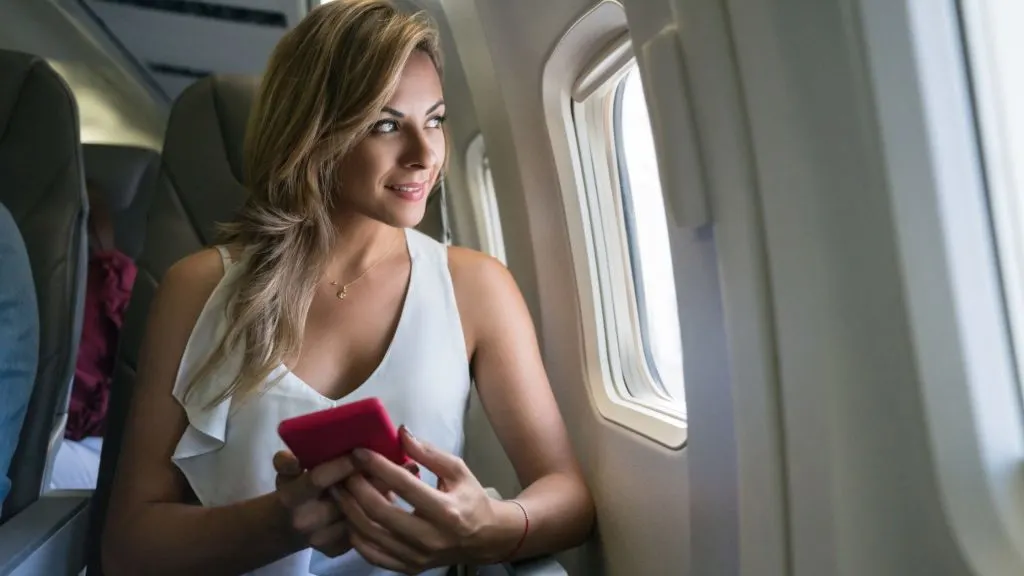
But, There’s a Catch…
While wi-fi aboard makes communication easier, there are still limitations. For instance, voice calls via the internet are restricted, even if texting is allowed.
Additionally, the speed and reliability of the airplane’s wi-fi can vary. Thus, while you can text, expecting a lightning-fast response might not always be feasible.
Inflight wi-fi can raise your blood pressure because of how excruciatingly slow it is. If you’re being given free access then you can chalk it up to a cloudy day, but if you paid for inflight wifi you’re going to be seething at the horrible service.
A Dive Into Airplane Mode
Airplane mode: We’ve all seen it, used it, and maybe even wondered about its actual purpose beyond just those flight attendant announcements. Here, we’re diving deep into this often misunderstood feature.
What Exactly is Airplane Mode?
At its core, airplane mode is a setting available on almost every modern mobile phone and some electrical devices. When activated, it disables the device’s cellular data, radio signals, and often Wi-Fi and Bluetooth functionalities. But, it’s more than just a simple on-off switch. It’s a power-saving, interference-preventing marvel.
The Real Purpose Uncovered
Most travelers believe that airplane mode solely exists to appease the FAA regulations and prevent potential interference with aircraft systems. And while that’s part of its purpose, it also plays a vital role for your device.
Continuously searching for a cellular network connection, especially at cruising altitude, can be a huge drain on your battery life. Thus, airplane mode serves a dual purpose: ensuring passenger safety and preserving your device’s energy.
People used to land in their destination and attempt to request an Uber, only to find their phone dead on arrival. It’s odd that airlines weren’t just honest with passengers about the best methods for preserving battery, such as turning off the phone or using Airplane mode.
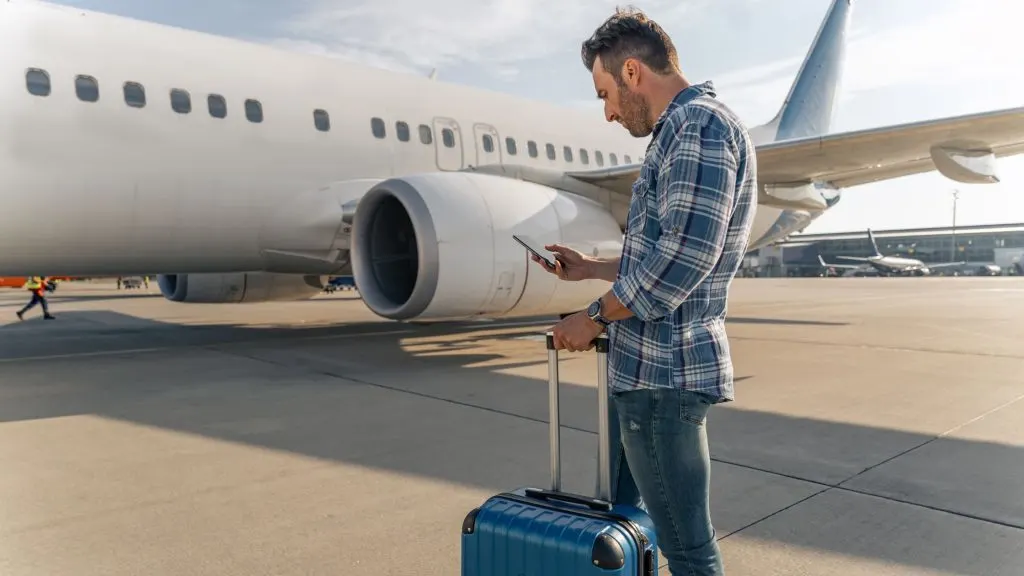
Beyond Just Cellular Network Suspension
While the primary function of airplane mode is to halt any cellular connection, many devices expand its functionality. For instance, some smartphones will also disable GPS, Wi-Fi, and Bluetooth, although these can often be re-enabled individually even when airplane mode is on.
This offers users the flexibility to choose which features they wish to use in-flight, like connecting to the aircraft’s wi-fi or pairing Bluetooth headphones for that movie marathon.
Airdrop Changes
Apple made a change to the default setting regarding AirDrop as a result of disturbing behavior happening on airplanes. Rouge passengers would AirDrop disturbing images of plane crashes to strangers within range.
For some reason the strangers would accept the Airdrop image and be horrified right before taking off or even in-flight. As a result of this behavior Apple altered the default to only allow contacts to Airdrop images. You can only allow strangers to Airdrop by turning on the function for a 15 minute period of time.
Airplane Mode vs Texting
To answer the burning question, “Can you text on a plane?”, understanding airplane mode is fundamental. It’s the first step towards deciphering in-flight communication, ensuring you remain compliant while maximizing your travel experiences.
Understanding FCC and FAA Regulations
Navigating the skies isn’t just about purchasing a ticket and boarding a plane. It also involves abiding by specific guidelines set by regulatory bodies. If you’ve ever wondered why flight attendants are so adamant about airplane mode and device usage, here’s a clearer perspective through the lens of the Federal Communications Commission (FCC) and the Federal Aviation Administration (FAA).
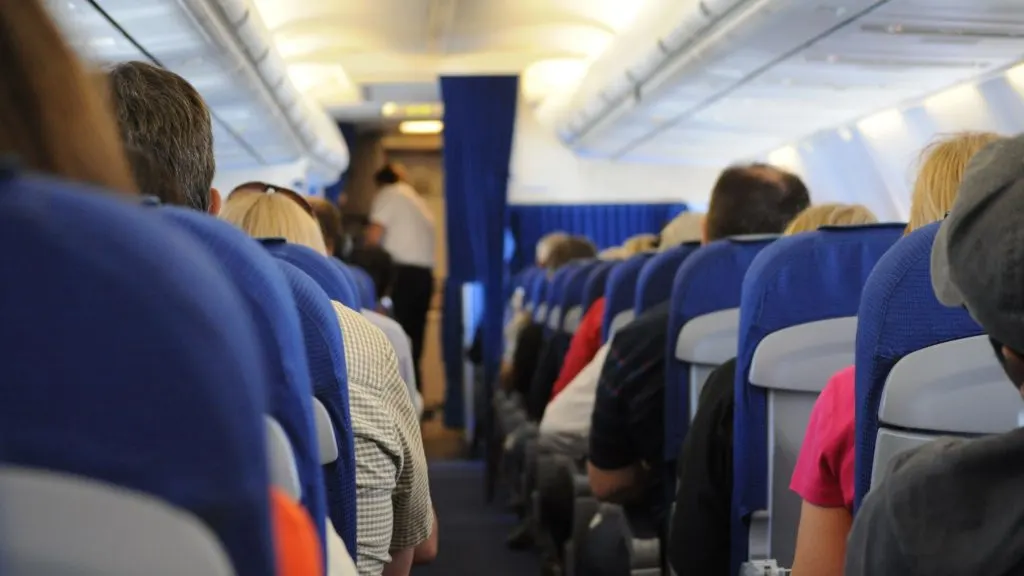
FAA: Protecting the Skies
The FAA, or Federal Aviation Administration, oversees the safety of civil aviation. When it comes to electronic devices, they’re primarily concerned with how they might interfere with an aircraft’s communication systems. Contrary to popular myths, the FAA regulations don’t outright ban the use of personal electronic devices.
Instead, they give airlines the autonomy to assess and decide when devices can be used. However, during certain phases of the flight, such as takeoff and landing, restrictions are more stringent for safety reasons.
All the seemingly pointless rules about having your seat upright, tray table stowed, and large electronics put away are really about being ready for an emergency. The most dangerous parts of a flight are during take off and landing, therefore being ready to evacuate during those times is of the upmost importance.
FCC’s Role in In-Flight Communication
While the FAA looks to the skies, the FCC, or Federal Communications Commission, regulates interstate and international communications. One of their main concerns? That mobile devices, when used in-flight, might interfere with cellular network connections on the ground.
This is why the FCC has long opposed in-flight voice calls, fearing that a plane full of chatty passengers could overload cell towers below. Cell phone signals are a critical safety net in an emergency and they want to reduce the chance of interference.
Wi-Fi: The Game Changer
Thanks to advancements in technology, airlines are now equipped with specialized in-flight wi-fi service that operates without conflicting with ground-based networks.
This has reshaped the conversation about in-flight device usage, giving travelers more freedom and easier access to stay connected. However, it’s essential to remember that while wi-fi might be available, voice calls, as per FCC guidelines, still remain prohibited on most commercial flights.
Compliant Phone Usage
It’s important to understand that while both the FCC and FAA have passengers’ best interests at heart, their guidelines serve different purposes. By grasping these nuances, you, as a traveler, can better appreciate the “whys” behind in-flight regulations and enjoy a seamless, compliant travel experience.
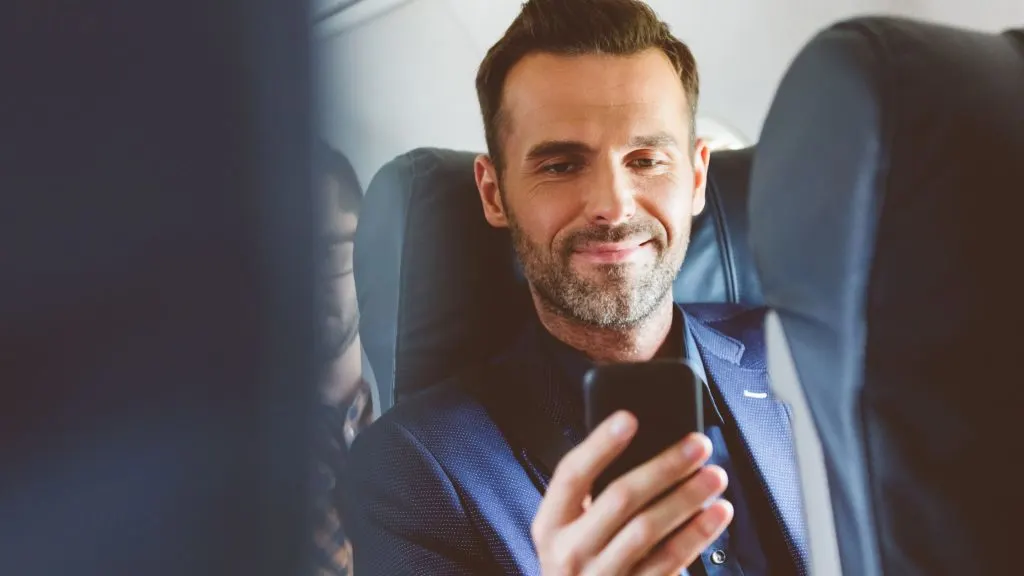
Ways to Text During Your Flight
With the sky as your backdrop, staying connected might seem a tad challenging. However, as the world has evolved, so have in-flight communication methods. If you’re wondering, “Can you text on a plane?”, here’s your go-to guide to keeping those SMS messages flowing.
Yes, you can text on a plane under certain conditions.
The Power of In-Flight Wi-Fi
The easiest way to remain connected above the clouds is through the aircraft’s wi-fi. Many airlines, like JetBlue Airlines and United Airlines, offer this feature.
Once connected to the wi-fi network, you can access various messaging apps. Facebook Messenger, Apple iMessage, WhatsApp and similar functionality apps at cruising altitude.
Free Wi-Fi: A Traveler’s Dream
Some airlines take connectivity a step further, offering free in-flight wi-fi. This means not only can you browse your favorite features on the web, but sending SMS text messages becomes a breeze.
For example, T-mobile customers flying with Delta Airlines can enjoy wi-fi throughout their journey within the United States. Do check with your airline before the flight, as free wifi deals and collaborations might differ between countries.
Offline Texting Options
For those on flights without wi-fi service or if you prefer not to purchase access, there’s still hope. Apps designed to work offline allow you to compose messages which will then be sent once you regain internet connection. While not instantaneous, it ensures your communication isn’t entirely halted.

Understanding App Limitations
Not all messaging apps are created equal. While you might have success with short message service (SMS) or SMS texts through certain platforms, others, especially those that rely heavily on high-speed wi-fi or cellular data, may not function optimally.
Including an image in your text message for example makes the communication a ‘media message’ which often isn’t included as part of the flight mode internet service provider. Texting links or GIF’s will also be dependent on weather the internet service provider supports it. Additionally, video calls, will likely be unavailable.
It’s always a good idea to have a couple of different communication apps on your smart phone to navigate any in-flight limitations.
Staying Connected Made Easy
With a mix of technological advancements and airline offerings, texting on a plane is more feasible now than ever before.
By understanding your options and being prepared, you can ensure that your travel experiences are not only memorable but also well-connected.
Texting Without Wi-Fi: Is It Possible?
In today’s connected age, the thought of going offline, even for a short period, might seem daunting.
For many, the question remains: “Can you text on a plane without relying on wi-fi?” Let’s debunk some myths and offer some clarity.
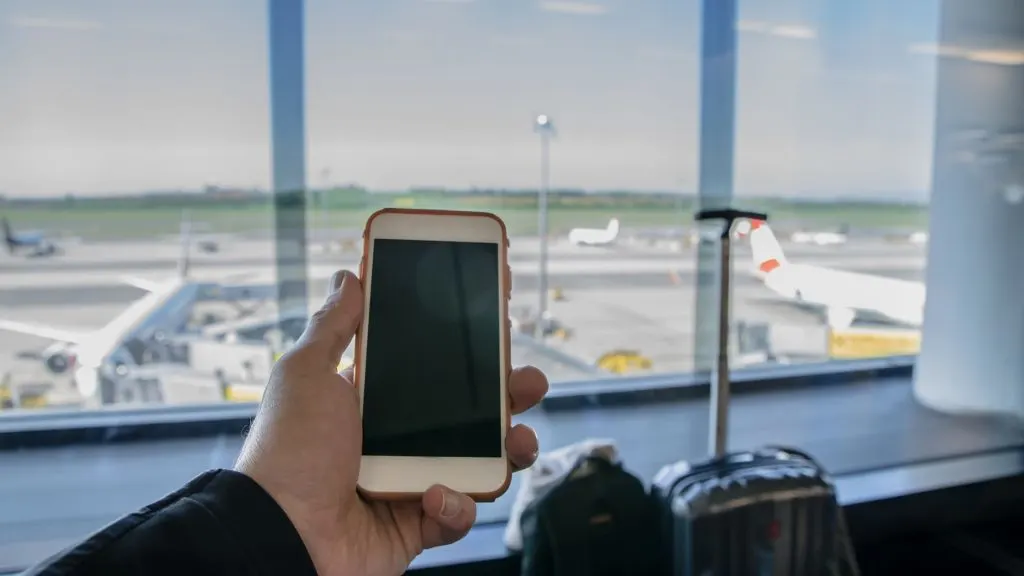
The Role of Cell Towers
When on the ground, our mobile phone relies heavily on cell towers for that seamless cellular connection. However, at 35,000 feet in the air, this connection becomes almost non-existent. Thus, traditional SMS messages via cellular network connection becomes a challenge, if not impossible.
Aircraft’s Communication Systems
While airplanes are equipped with their own communication systems to connect with air traffic controllers, these systems aren’t designed for passenger cellular data use.
Leveraging them for personal communications could lead to potential interference, which is a primary reason behind FAA regulations urging passengers to switch to airplane mode.
Offline Messaging Apps to the Rescue
While you might not be able to send SMS texts in the traditional sense, technology has paved the way for offline messaging solutions. Apps designed to queue your messages offline ensure that once you land and reconnect to a cellular network or wi-fi service, your texts get sent. It’s not real-time communication, but it guarantees your messages won’t be left unsent.
The Power of Bluetooth
For those traveling with companions on the same flight, Bluetooth functionalities of your device can be a game-changer. Apps leveraging Bluetooth allow passengers to chat without needing an internet connection. It’s a fantastic workaround, especially for frequent traveler groups wanting to stay in touch during their flight.
Many budget friendly tickets are offering for you to book seats without selecting it yourself. This often results in groups of passengers traveling together being split up within the plane. Re-enable bluetooth after turning on airplane mode in order to keep your phone open to communication with your travel buddies.
Texting Without Wi-Fi
While wi-fi remains the most common way to stay connected in the skies, it’s not the only way. With a blend of innovation and a bit of pre-flight preparation, ensuring your messages reach their destination, even without a wi-fi connection, becomes a feasible task.

Costs Behind In-Flight Texting
In the era of instant communication, being connected even while cruising amidst the clouds is almost a necessity. But just as with most services, there’s a price tag attached. If you’ve been pondering, “Do you have to pay to text on a plane?”, this section will provide clarity on the potential costs.
Free Wi-Fi: A Blessing for Some
Many airlines understand the appeal of staying connected, and as a result, offer complimentary in-flight wi-fi. For instance, carriers like JetBlue Airlines and Hawaiian Airlines occasionally provide free internet access without an additional charge.
However, always check your airline’s current offerings, as these promotions can vary. Sometimes all that is offered is free texting, while other times full fledged internet access is available.
Special Deals and Partnerships
Airlines often collaborate with mobile carriers to offer exclusive deals. T-Mobile customers, for example, may enjoy free wi-fi on select domestic flights. Many domestic airlines have the T-Mobile partnership prominently featured on their wi-fi connection page.
Other companies such as travel credit cards offer free wi-fi options to their customers. While certain credit card companies ask you to pay for the service and issue the money back to you as a credit. Such partnerships provide travelers with easier access to communication without denting their wallets.
Paid In-Flight Wi-Fi Packages
Not all flights come with free wi-fi access. In cases where there’s a fee, airlines usually offer tiered packages. The basic package might allow for text messaging and light browsing, while premium packages offer high-speed wi-fi suitable for streaming and video calls.
These packages can range anywhere from a few dollars for short flights to heftier prices for longer journeys or unlimited access.

Hidden Costs of SMS Messaging
If you’re thinking about bypassing wi-fi and attempting to text via a cellular connection (where permissible), be wary. Roaming charges can be exorbitant, especially on international flights.
It’s always wise to check with your service provider before embarking on your journey to avoid any unpleasant bill surprises.
Navigating the Costs
While staying connected is wonderful, it’s essential to be mindful of potential costs. Whether you’re leveraging the airplane’s wi-fi or considering alternative communication methods, being informed ahead of your flight ensures a smooth and cost-effective travel experience.
What Not To Do On A Plane
As we revel in the possibilities of in-flight communication, it’s equally vital to recognize the boundaries. With the recurring question, “Can you text on a plane?” answered, it’s time to dive into practices you should ideally avoid while soaring the skies.

Forgoing Airplane Mode
Tempting as it might be, neglecting to switch your mobile phone to airplane mode can pose risks. Electrical devices, especially cell phones, emit radio signals. These can potentially interfere with the aircraft’s navigation systems.
The Federal Aviation Administration (FAA) emphasizes this as a safety measure, so always adhere to flight attendants’ instructions. You don’t want to be the one who causes some sort of electromagnetic interference.
Years ago if you had an Android phone, specifically a Samsung, there was a risk of it catching fire in-flight. Cell phone manufactures makes mistakes and always having the newest technology could put a flight at risk.
Making Cell Phone Calls
While texting might be permissible via wi-fi, making cell phone calls during a flight is a different ballgame. Not only is it against FAA regulations in the United States, but it can also be disruptive to fellow passengers and interfere with communication systems. Voice calls via the airplane’s wi-fi might be allowed on some flights, but it’s always best to check with the airline’s policies.
Excessive Streaming without Premium Packages
We all have that favorite TV show we can’t miss. But if you’re on a flight with limited wi-fi access, streaming without the appropriate package can bog down the network for other passengers.
If watching Netflix on a plane is on your agenda, ensure you’ve opted for high-speed wi-fi packages or downloaded your content before boarding.
Ignoring Battery Life
With all this talk of connectivity, remember your mobile phone’s battery life. Constantly being connected can drain your battery, leaving you in a lurch by the time you land. Ensure you either have a portable charger or use the on-board charging facilities if available.
When you click on an Amazon link from my site the price is the same as if you searched for it yourself, but I get compensated. As an Amazon Associate I earn from qualifying purchases.
Avoiding Bluetooth Overuse
Bluetooth headphones and AirPods can be a frequent traveler’s best companions. However, remember to turn off other Bluetooth functionalities of your device when not in use, to prevent unnecessary interference with the plane’s communication devices.

The Takeaway: Travel Smart
While the advancements in technology have made our flights more comfortable and connected, it’s crucial to be a responsible traveler. By respecting guidelines and ensuring the comfort of your fellow passengers, you can ensure a pleasant and hassle-free journey for all.
Alternatives and Entertainment Options In-Flight
Flying can sometimes feel like a journey in suspended time, especially on longer hauls. While the question, “Can you text on a plane?” might have been pressing on your mind, there’s a whole world of in-flight entertainment and alternatives waiting to be explored. Let’s delve into these exciting options.
Explore In-Flight Entertainment Systems
Airlines like British Airways, American Airlines flights, and Qantas Airlines have upped their game with state-of-the-art in-flight entertainment systems.
From blockbuster movies, TV shows, to interactive games, these systems ensure that boredom remains miles away. Plug in your headphones, settle into your seat, and get whisked away.
Listen to Music or Podcasts
Switch on your smartphone, connect it to the airplane’s wi-fi or enable airplane mode, and drift into your own world of melodies. Whether it’s using Spotify, Apple Music, or diving into an engaging podcast episode, music is a traveler’s best friend.
Remember, downloading your favorite tracks before flying provides easier access without relying on wi-fi.
Dive into E-Books or Audiobooks
Why not use this uninterrupted time to catch up on some reading? With platforms like Kindle or Audible, your journey can turn into an intellectual retreat. The best part? E-books and audiobooks don’t rely on a wi-fi connection once downloaded.

Engage in Offline Mobile Games
Mobile devices have transformed into mini-gaming consoles. Before your flight, download games that function offline. If you are traveling with children make sure you have rules about tech time clearly established.
Whether it’s a strategy game, a puzzler, or a narrative-driven adventure, it’s one of the best ways to pass the time. But keep in mind that high scores won’t be reported to the internet when in offline mode.
Work or Plan Ahead
The frequent traveler often sees flights as a time to catch up on work or plan their next steps. With offline apps like Trello, Notion, or simple note-taking tools, you can sketch out your thoughts, draft emails, or even outline your next big project.
Engage in On-Board Socializing
Old school but gold. Sometimes, the most exciting conversations can be struck up with a fellow traveler sitting next to you. Share travel experiences, stories, or simply chat about the destination ahead.
Sleep
Use your time in the sky to get some shut eye. Window seats allow you to lean up agains the wall for a more comfortable nap. Whereas, middle and aisle seats can practice their straight up and resting.
Get Up From Your Seat
Despite common behavior, you aren’t actually required to stay in your seat the entire flight. As long as the fasten seat belt sign is off, indeed you can get up and stretch your legs.
Feel free to walk about the cabin to stretch your legs. Use the bathroom during non-peak times.
It is common for long flights to provide a open snack bar at the back of the plane for your enjoyment.
Keeping your body active is the best way to prevent blood clots and stiff joints during travel.
The Sky’s the Limit: Mix and Match
In-flight entertainment is as vast as the sky itself. By mixing and matching the above methods, every flight can be a new experience, keeping monotony at bay. Yes you can text on the plane, but you can also do so much more.

International Flights: A Different Ball Game
So, we’ve navigated the realm of domestic skies and the frequently asked, “Can you text on a plane?” But what about when you’re soaring over international waters? International flights introduce a fresh set of rules, features, and quirks that differ from your domestic escapades. Let’s decode this exciting world.
Connectivity Across Borders
International flights often offer a broader range of connectivity options. Free in-flight wi-fi or premium high-speed wi-fi might be available, offering passengers easier access to their favorite features.
Airlines like British Airways and Hawaiian Airlines, for instance, often provide complimentary or tiered wi-fi service for their patrons.
Varied Messaging Apps and Restrictions
While SMS texts or messaging apps like Facebook Messenger might be universally recognized, certain countries might have restrictions on platforms like WhatsApp or social media apps. Before you hop onto that aircraft’s wi-fi, ensure you’re aware of the destination’s digital landscape.
Roaming Charges and Cellular Data
Remember, once you land in a foreign country and switch off the airplane mode, roaming charges might apply if you haven’t activated an international plan. It’s always a good idea to check with your service provider about international rates and data packs.

In-Flight Entertainment Galore
If you thought domestic flights had an impressive array of entertainment, wait until you experience international flights. From a vast selection of international movies, music genres from around the globe, to multi-lingual TV shows – it’s a cultural fiesta at 35,000 feet.
Language Barriers and Solutions
Planning to text or use the in-flight entertainment system? You might come across multiple language options. Most modern flights offer touchscreens with multi-language support. Plus, translation apps can be your best friend in bridging any communication gaps.
Extended Flight Durations: Plan Your Activities
With international flights often lasting many hours, planning is key. Mix and match activities – from working on your laptop, watching a movie, reading, or even catching some shut-eye. It ensures you land feeling refreshed and ready for your adventure.
Jet Setting Smartly
International journeys, while exciting, come with their own set of challenges and offerings. Being prepared and informed ensures that you maximize your in-flight experience, making every moment count.
Final Tips and Tricks for In-Flight Communication
As we wind down our deep dive into the world of in-flight communication, the recurring theme, “Can you text on a plane?” becomes more clear. While we’ve covered the essentials, a few handy tricks and tips can make your communication experience during flights even more seamless. Let’s take a look.
Pre-Download Essential Apps
Before boarding, ensure you’ve downloaded essential messaging apps, especially if you’re a frequent traveler. Platforms like Facebook Messenger, WhatsApp, and similar functionality apps will keep you connected even above the clouds. Remember, the easiest way is to have them on hand, so you’re not scrambling for downloads mid-air.
Preserve Your Battery Life
Long flights can be taxing on your smartphone’s battery. To save power, dim your screen, close unnecessary apps, and switch on airplane mode when not using the internet connection. Portable chargers or power banks can also be a lifesaver.
Optimize Your Wi-Fi Connection
Wi-fi network on planes can be spotty. To get the best out of it, limit heavy internet activities like video calls or large downloads. Focus on SMS messages, browsing, or light activities that don’t strain the aircraft’s wi-fi.
Stay Informed on FCC and FAA Regulations
As we’ve covered, the Federal Communications Commission and Federal Aviation Administration have specific regulations about cell phone usage and more. Staying updated ensures you’re always in compliance and can enjoy a hassle-free flight.

Respect Fellow Passengers
While it’s great to have the ability to text or make voice calls using the airplane’s wi-fi, be mindful of your surroundings. Not everyone might appreciate a loud conversation or the sound from your mobile devices. Headphones, especially noise-cancelling ones, can be a boon here.
Explore Premium In-Flight Packages
For those who need high-speed wi-fi, some airlines offer premium packages that provide faster internet connection speeds and other benefits. It might cost a little more, but for those who value connectivity, it’s often worth it.
Communication Beyond Text
Texting is just the tip of the iceberg. From social media apps, email, to various platforms offering similar functionality, there’s a plethora of ways to stay connected. Explore, experiment, and find what works best for you.
Journey Smartly and Stay Connected
With these final pearls of wisdom, you’re now fully equipped to navigate the skies without missing a beat in your communications.
Remember, while the technological realm offers numerous ways to connect, sometimes, looking out of the window and soaking in the beauty of the skies is the best connection of all.

The World Above and Staying Connected
“Can you text on a plane?” – a question that has echoed through terminals, lounges, and across the travel-sphere. With this comprehensive guide, we’ve ventured deep into the intricacies of in-flight communication, debunking myths and enlightening realities.
The Power of Knowledge
Being informed about FCC regulations, FAA rules, and the ways airlines are working towards easier access to communication for passengers has empowered us as travelers.
This guide is more than just information; it’s your passport to staying connected, whether you’re on a short domestic jaunt or jet-setting internationally.
The Future is Bright (and Connected)
With advancements in technology, airlines are continuously enhancing their in-flight wifi services.
Soon, a day might come where free wi-fi isn’t a luxury but a given, making it an essential part of our travel experiences.
Travel with Purpose and Presence
While it’s exhilarating to have the world at our fingertips, sometimes the best way to travel is to disconnect from the virtual and connect with the real. The sights from your window seat, the stories of a fellow traveler, or even a chat with the flight attendants – these moments are as precious as any message or call.
As we descend from our journey through the digital clouds, it’s time to pack away our gadgets, knowledge, and memories. But remember, whether you’re engaging in SMS text messages or marveling at the world below, travel is about balance. Staying connected and savoring the moment are not mutually exclusive; they can harmoniously coexist.
Now you know you can text on a plane, but feel free to just unplug and enjoy the ride.

![Can You Text on a Plane In-Flight? [Complete Guide]](https://veronicahanson.com/wp-content/uploads/2023/10/Can-I-Text-on-a-Plane-or-Use-Internet-728x546.jpg.webp)

https://mototechbd.com/motul-seller-bangladesh/
Thank you for the wonderful links and resources.